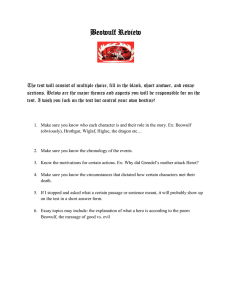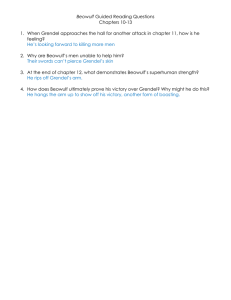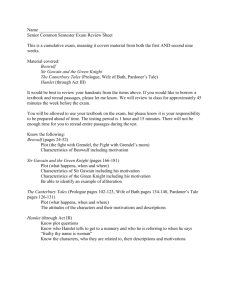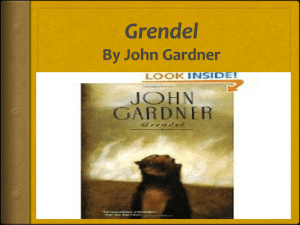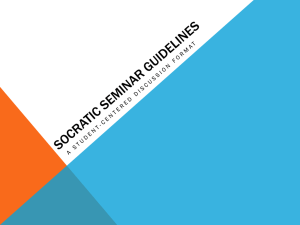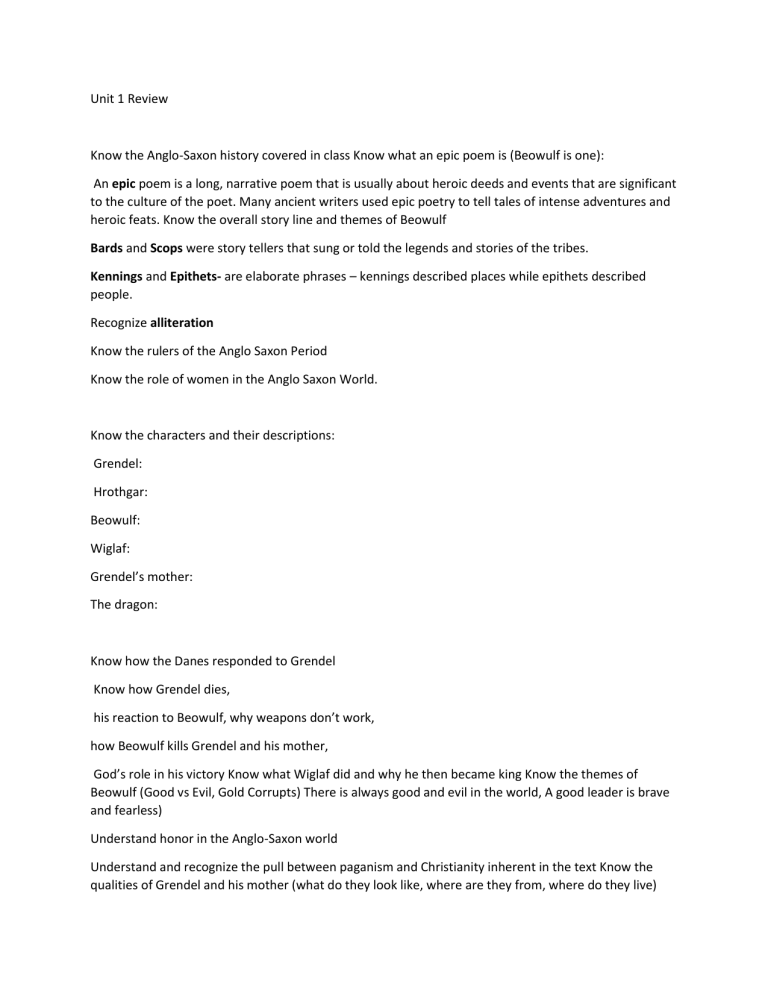
Unit 1 Review Know the Anglo-Saxon history covered in class Know what an epic poem is (Beowulf is one): An epic poem is a long, narrative poem that is usually about heroic deeds and events that are significant to the culture of the poet. Many ancient writers used epic poetry to tell tales of intense adventures and heroic feats. Know the overall story line and themes of Beowulf Bards and Scops were story tellers that sung or told the legends and stories of the tribes. Kennings and Epithets- are elaborate phrases – kennings described places while epithets described people. Recognize alliteration Know the rulers of the Anglo Saxon Period Know the role of women in the Anglo Saxon World. Know the characters and their descriptions: Grendel: Hrothgar: Beowulf: Wiglaf: Grendel’s mother: The dragon: Know how the Danes responded to Grendel Know how Grendel dies, his reaction to Beowulf, why weapons don’t work, how Beowulf kills Grendel and his mother, God’s role in his victory Know what Wiglaf did and why he then became king Know the themes of Beowulf (Good vs Evil, Gold Corrupts) There is always good and evil in the world, A good leader is brave and fearless) Understand honor in the Anglo-Saxon world Understand and recognize the pull between paganism and Christianity inherent in the text Know the qualities of Grendel and his mother (what do they look like, where are they from, where do they live) Know the overall story line of The Canterbury Tales Know the starting and stopping points of pilgrimage Know the history about Thomas Becket and the King- Know the history between St. Thomas a Becket and the king- LOOK IT UP. Know what a frame story is and how The Canterbury Tales fits this definition Know the descriptions of the Canterbury pilgrims. A. Miller AB. Knight B. Doctor AC. Squire C. Oxford Cleric D. Wife of Bath AD. Cook AE. Nun BC. Parson E. Skipper/Shipman BD. Pardoner 30. “All his apothecaries in a tribe/Were ready with the drugs he would prescribe,/And each made money from the other’s guile;…/ 31. “who from the day on which he first began to ride abroad had followed chivalry,/Truth, honor, generousness and courtesy.” 32. “A lover, and a cadet, a lad of fire/With locks as curly as if they had been pressed.” 33. “…had hair as yellow as wax,/Hanging down smoothly like a hank of flax./In driblets fell his locks behind his head/Down to his shoulders which they overspread; Thinly they fell, like rat-tails, one by one.” 34. “In company she liked to laugh and chat/And knew the remedies for love’s mischances,/An art in which she knew the oldest dances.” 35. “His beard, like any sow or fox, was red/And broad as well, as though it were a spade;/And at its very tip, his nose displayed/A wart on which there stood a tuft of hair./Red as the bristles in an old sow’s ear.” 36. “But what a pity—so it seemed to me,/That he should have an ulcer on his knee.” 37. “A tone of moral virtue filled his speech/And gladly would he learn, and gladly teach.” 38. “She used to weep if she but saw a mouse/Caught in a trap, if it were dead or bleeding./And she had little dogs she would be feeding/With roasted flesh, or milk, or fine white bread.” 39. “And certainly he was an excellent fellow./Many a draught of vintage, red and yellow,/He’d drawn at Bordeaux, while the trader snored.” 40. “This noble example to his sheep he gave/That first he wrought, and afterwards he taught;/And it was from the Gospel he had caught/Those words, and he would add this figure too,/That if gold rust, what then will iron do?” Know the plot of Sir Gawain and the Green Knight Know how Sir Gawain and the Green Knight fit into the category of a medieval romance Understand the definition of Chilvarly Know the characters: Sir Gawain: The Green Knight/Bertilak de Hautdesert: Lady Bertilak: King Arthur: Guinevere: Old Lady/Morgan le Fay: Servant assigned to guide Gawain to the green chapel

